The AMD Llano Notebook Review: Competing in the Mobile Market
by Jarred Walton & Anand Lal Shimpi on June 14, 2011 12:01 AM ESTApplications, Round Two: Treading Water
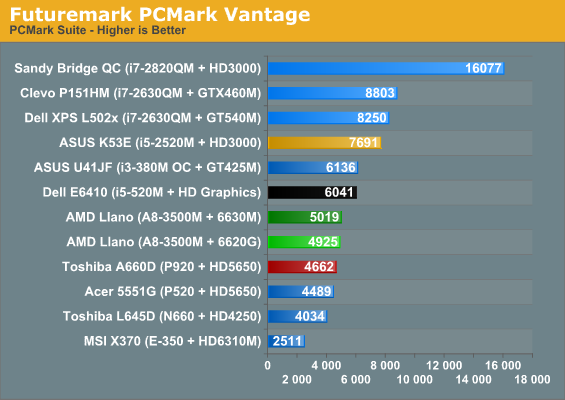
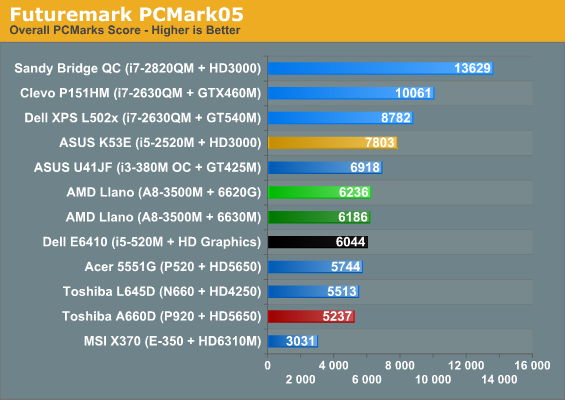
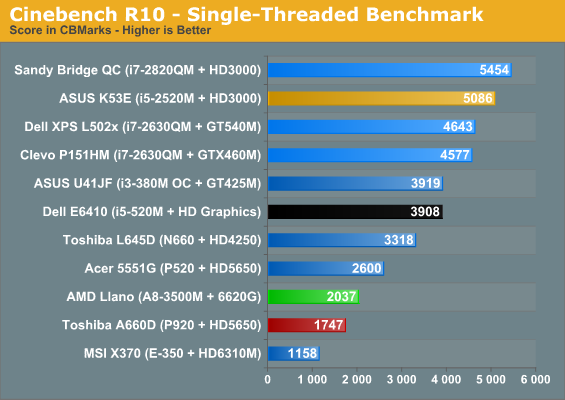

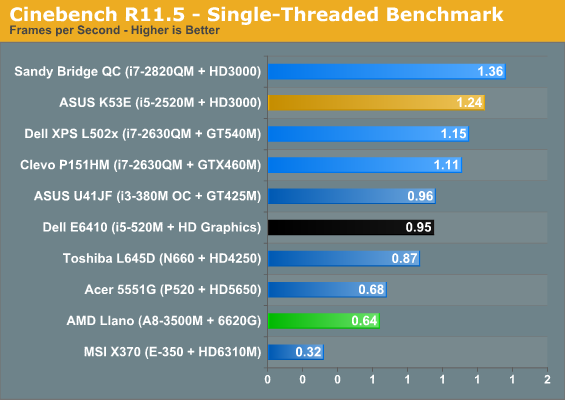
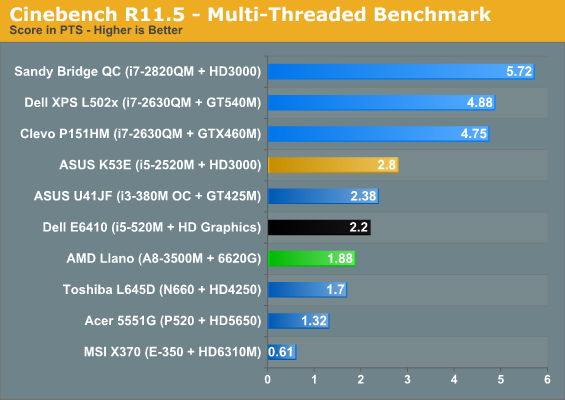
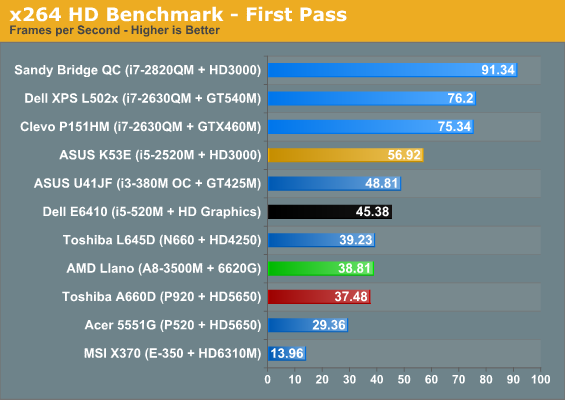
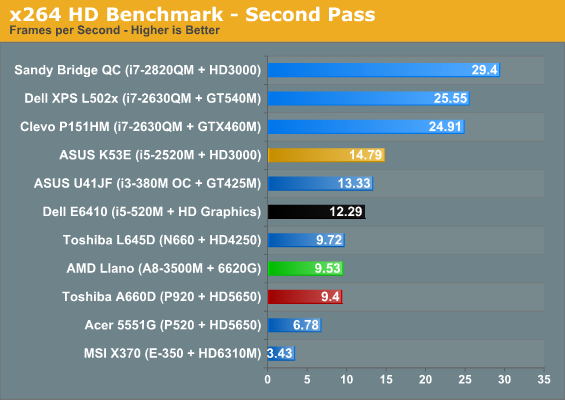
This time we have a more interesting competitor to look at: the Toshiba A660D. AMD says Turbo Core works at speeds of up to 2.4GHz on the A8-3500M, but we have no way of monitoring the actual CPU clocks right now. (CPU-Z if you’re wondering shows a constant 1.5GHz, but AMD says that utility doesn’t currently detect the proper clocks.) When we compare performance results between the Llano notebook and the A660D, we definitely see some differences in performance. Some of that may come from the added L2 cache and other architectural tweaks, but Cinebench R10 in particular shows a healthy 17% performance increase, even with a base clock that’s 7% lower. In the multi-threaded Cinebench result, the lead drops to 10%, which correlates well with how we’d expect Turbo Core to work. PCMark Vantage is still heavily influenced by the storage subsystem, and the storage score of 2950 on the A660D versus 3791 on the Llano suggests the Toshiba HDD is a significant bottleneck.
Looking at other laptops and tests where we’re looking purely at CPU performance, suddenly Llano starts to struggle. The Arrandale i5-520M offers 92% higher single-threaded performance in Cinebench R10 and 48% better single-threaded performance in R11.5; multi-threaded performance also goes to Arrandale, with a 23% lead in R10 and 17% lead in R11.5. x264 also gives Arrandale a decent lead, with i5-520M 17% faster in the first pass and 29% faster in the more intense second pass. The overclocked i3-380M in ASUS’ U41JF tells a similar tale—and both of these laptops are running processors from early last year. When we shift to Sandy Bridge, even without looking at the quad-core parts AMD’s CPU performance is tenuous. The i5-2520M is anywhere from 50 to 150 percent faster depending on which test we look at; even if we toss out the older Cinebench R10 single-threaded result of 150%, R11.5 given the 2520M a 94% lead. In general, then, a moderate dual-core Sandy Bridge i5-series processor looks to be at least 30% faster, so quad-core Llano really only competes with Core i3 and its lower, non-Turbo clocks.
None of the results here are particularly surprising; K10.5 even at 32nm is still largely the same performance. AMD has focused this round up upgrades more on reducing power consumption rather than increasing performance, and that’s a perfectly reasonable approach for a mobile CPU. Most of us probably aren’t doing 3D rendering, CAD/CAM, or unassisted video transcoding on our laptops anyway. It would still be great to see AMD offer up an equivalent to Intel’s Quick Sync; they have the better GPU architecture, but a dedicated decoder like Quick Sync can clearly pay dividends. Outside of that one deficit the reality is that Llano is still plenty fast. Slapping an SSD into Llano will make more of a difference than upgrading an HDD-based Llano laptop to Core i5, so if you’re looking for an inexpensive laptop that can do everything most users need, Llano is very appealing.










177 Comments
View All Comments
whoaaaaaaaa - Tuesday, June 14, 2011 - link
A lot. I think you are very out of touch. No one buys desktops anymore, everyone uses a laptop - and quite a few people want to WOW or COD on them.luniq - Tuesday, June 14, 2011 - link
Agreed. A lot of people I know uses laptop although they rarely need to take it with them and they game too.swaaye - Tuesday, June 14, 2011 - link
I don't think he is. Most computer users don't play games. All they need is a GPU that can run the OS's UI.cotak - Tuesday, June 14, 2011 - link
The sort of people who use laptops and are pushing the CPUs hard are in the reality of the real world a limited bunch. Those who really need the power aren't going to be on a laptop anyhow like you say. Most office staff never use to the full potential of their issued computers even when they were using pentium 4s. And I actually think you'll find a lot of office workers are still humping around a P4 in their laptop bag.This is especially true as a lot of work now a days are done server side. About the only "office workers" who pound their CPU are those with big spread sheets. Even there I do not think you'll find many office workers who'd have an issue with most modern CPUs. They'll just go for a smoke or coffee break while it crunches.
And what review did you read that say there's no advantage in battery life? If you are pushing a game Llano lasts twice as long on the same battery.
voidi - Tuesday, June 14, 2011 - link
Lots of potential, they managed to find a valid niche in Intel's Netbook Hardware Portfolio. I think it's futile to argue about the success of this solution already, as the price will be the determining factor.As I see it, Llano has the potential to bring AMD back in the mobile market on a reasonable scale, but it also has the potential to utterly fail. Since it can't compete in the high-end area in either CPU or GPU performance, it will all depend on the value for your money. If the price is low enough, Llano will fill its niche quite comfortably.
Personally, I will wait for Trinity and Ivy Bridge, as both promise significant improvements and will likely be priced close to their predecessors.
jaydee - Tuesday, June 14, 2011 - link
On the one hand, I'm pleasantly surprised that AMD was able to bring the power draw of a K10/10.5 down to those levels, while adding decent GPU. It's a big step up for the to be in the discussion again for laptops. I don't think anyone could have reasonably expected them to go from Danube up to Intel's SB performance level overnight, so from that perspective, it's a big jump for them.On the other hand, it couldn't be more obvious that this product should have been competing against Arrendale about 18 months ago at the price point introduced today. I want to like this product badly, but it's so hard given it's CPU performance. Sure it's great for mid-range mobile gamers, but why would anyone else look at llano? Hopefully AMD can make just as big of a stride with BD-based mobile Fusion within the next 24 months, and then we can perhaps take AMD seriously in the bigger mobile market segments.
Gunbuster - Tuesday, June 14, 2011 - link
Will this mean the lowest common denominator HP $450 laptop of the week the everyone on a budget inevitably buys at retail when they are in a time crunch will suck less?I sure hope so.
Boissez - Tuesday, June 14, 2011 - link
I actually like the performance as it seems better balanced than in the dual-core Sandy bridges, ie., about 50% performancethe in single threads apps, 80% in multi-threaded apps and 200% in gaming. IOW better suited towards consumer needs. And battery life is good too.What AMD needs to work on though is lowering the TDP. A8-3500 performance in a 25W enveloppe would allow this to be a good alternative in the upcoming ultrabooks (especially because you can't fit a discrete GPU in those)
Boissez - Tuesday, June 14, 2011 - link
Oh yeah and make all of those APU's compatible with 1600 and 1866 Mhz RAM. RAM speed seems to be a major bottleneck in this platform.ET - Wednesday, June 15, 2011 - link
I think that even lower performance in 25W would be attractive, but it might eat into the E-350 market, unless it's priced significantly higher. I don't think it'd be a big problem for AMD to lower power to that point (certainly for A4), but they're probably waiting to see where the market goes with the current Llano APU's. I believe we'll see a 25W version later this year.